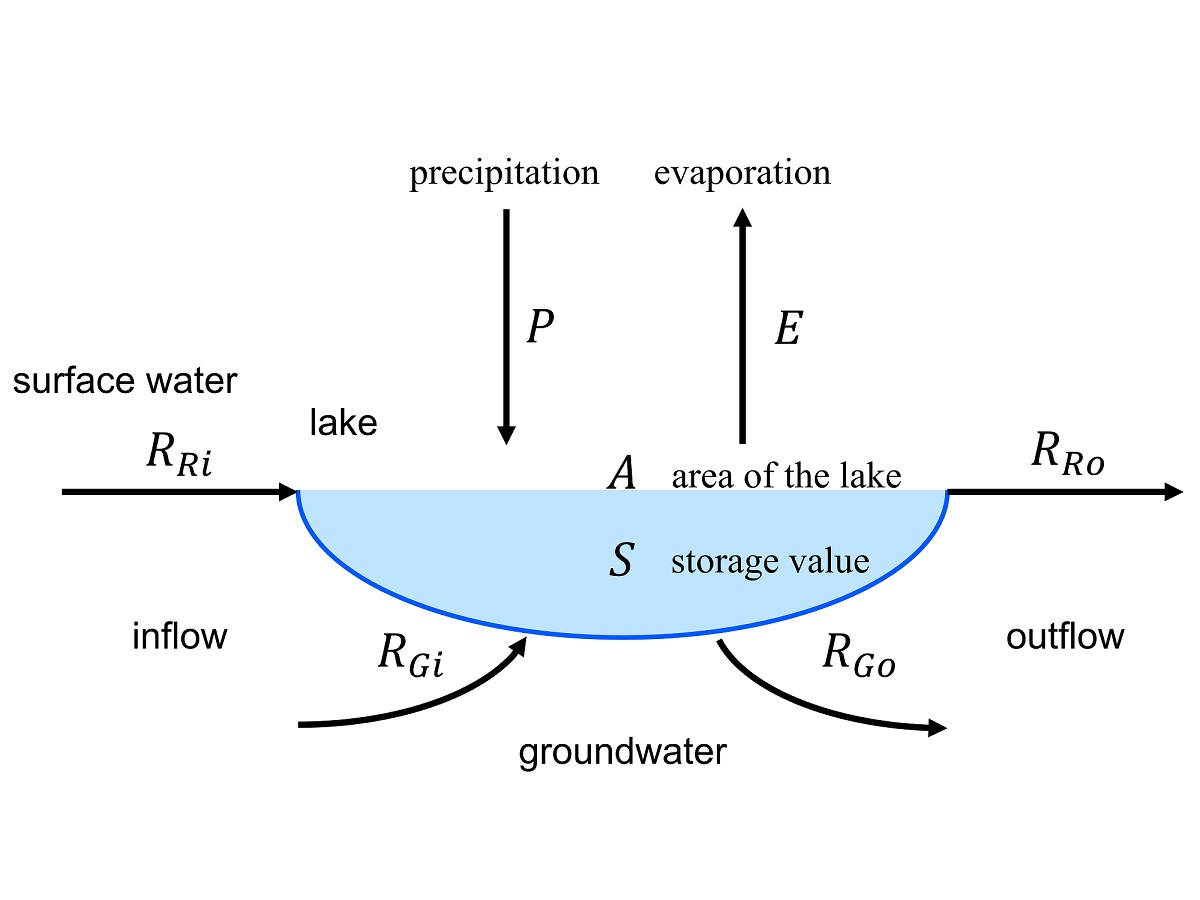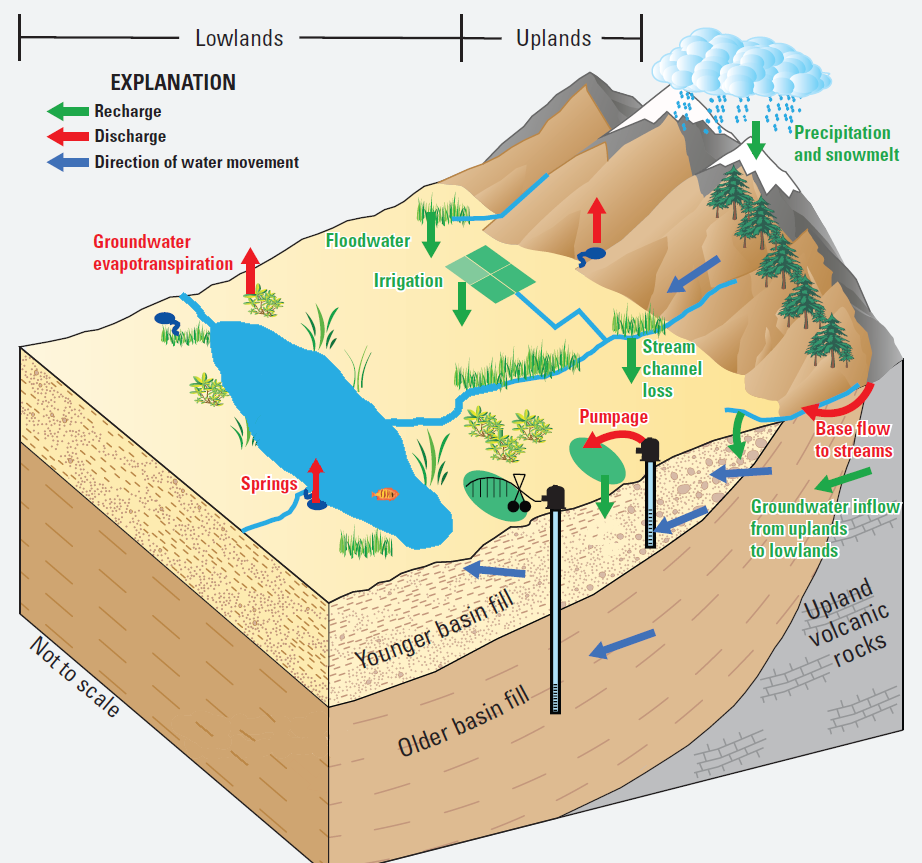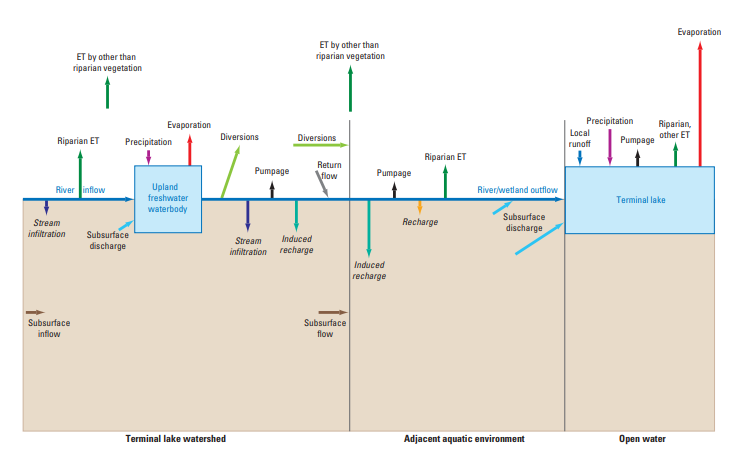IB Syllabus focus:
‘Use input–output flow diagrams for lakes/aquifers to determine steady state and calculate sustainable rates of water harvesting.’
Understanding steady state and sustainable withdrawals is central to analysing water systems. These concepts help determine how human water use interacts with natural replenishment, ensuring resources remain viable for long-term needs.
Steady State in Water Systems
Definition of Steady State
Steady State: A condition in which the inputs to a system equal the outputs, resulting in no long-term change in the size of the stores.
In the context of lakes or aquifers, steady state is achieved when the inflows of water (such as precipitation, river inflow, or recharge) balance the outflows (such as evaporation, abstraction, or seepage). This balance allows the system to remain stable over time, even though individual flows may fluctuate seasonally.
Visualising with Flow Diagrams
Flow diagrams are a common tool in IB ESS for representing these dynamics:
Boxes represent stores (e.g., a lake, an aquifer).
Arrows represent flows into or out of the system (e.g., infiltration, withdrawal, evaporation).
The diagram allows for identification of imbalances when arrows differ in size, indicating whether the system is in surplus, deficit, or steady state.

Schematic of a lake with labelled inputs (precipitation, river and groundwater inflow) and outputs (evaporation, river and groundwater outflow), plus the storage term. It directly illustrates the water-balance idea used to test for steady state; an accompanying equation is shown on the source page. The equation detail slightly exceeds IB ESS SL requirements but reinforces the inputs–outputs–storage concept. Source.
Inputs and Outputs in Aquatic Systems
Key Inputs
Precipitation: Direct rainfall onto the surface or recharge into groundwater.
Surface inflows: Streams, rivers, or runoff entering the store.
Groundwater recharge: Water percolating down to aquifers.
Key Outputs
Evaporation: Loss of water due to heat and solar radiation.
Transpiration: Movement of water from vegetation near the system.
Surface outflows: River discharge downstream.
Human withdrawals: Abstraction for agriculture, industry, or domestic use.
When outputs are consistently greater than inputs, stores decline, risking depletion.
Sustainable Withdrawals
Sustainable Withdrawal: The rate of resource use that does not exceed the system’s natural replenishment, ensuring availability for present and future generations.
For water systems, sustainable withdrawals mean harvesting water from lakes or aquifers at a rate equal to or lower than natural recharge. Overextraction results in falling groundwater tables, shrinking lakes, and ecological harm.

Conceptual cross-section of a groundwater basin showing recharge (precipitation, floodwater, irrigation), discharge (springs, baseflow, ET), and pumping-induced drawdown. It clarifies how abstraction alters flows and storage when evaluating sustainable withdrawal rates. Geological layer labels exceed IB depth but do not distract from the input–output focus. Source.
Importance of Sustainable Rates
Maintaining sustainable withdrawal rates ensures:
Long-term water security for human consumption.
Protection of ecosystems, as many rely on groundwater or steady lake levels.
Avoidance of economic losses, since depleted aquifers or lakes are costly and difficult to restore.
Calculating Sustainable Rates
Use of Input–Output Diagrams
These diagrams provide a structured way to determine if a water body is in steady state:
Measure annual inflows (rainfall, river input, recharge).
Measure annual outflows (evaporation, discharge, withdrawals).
Compare totals:
If inflows = outflows, the system is at steady state.
If outflows > inflows, the system is being depleted.
If inflows > outflows, the system is in surplus.

Diagram of hydrologic inputs and outflows for a terminal lake and its watershed, illustrating precipitation, inflows, recharge, evaporation, outflows, and human withdrawals/returns. This supports steady-state assessment by comparing summed inputs and outputs. Labels such as “riparian ET” and “diversions” add detail beyond the IB syllabus but remain consistent with water-budget thinking. Source.
Conceptual Equation
Water Balance = Inputs – Outputs
Inputs = Precipitation + Inflows + Recharge
Outputs = Evaporation + Outflows + Withdrawals
A sustainable withdrawal occurs when this balance remains zero or positive over the long term. Persistent negative balances indicate unsustainable use.
Impacts of Unsustainable Withdrawals
Groundwater Depletion
When aquifers are over-pumped:
Falling water tables increase pumping costs.
Subsidence may occur, permanently reducing aquifer capacity.
Saline intrusion can contaminate freshwater in coastal aquifers.
Lakes and Surface Waters
Over-withdrawal from lakes leads to:
Shrinking surface areas and reduced depth.
Loss of biodiversity as aquatic habitats are destroyed.
Conflict among users, particularly in regions dependent on a single freshwater source.
Human Influences on Steady State
Agricultural Use
Irrigation is often the largest consumer of water. Unsustainable irrigation reduces aquifer levels and alters lake balances.
Urbanisation and Industry
Growing populations increase withdrawals for domestic supply and manufacturing. Without regulation, outflows may permanently exceed inflows.
Climate Variability
Changes in precipitation patterns or droughts reduce natural inflows, making sustainable management even more critical.
Achieving Sustainable Water Management
Monitoring and Regulation
Use of flow diagrams to track balances.
Establishing abstraction limits based on measured recharge rates.
Enforcing quotas to prevent overuse.
Technological Solutions
Drip irrigation to reduce agricultural demand.
Recycling and reusing water in industry.
Artificial recharge techniques to enhance groundwater stores.
Community and Policy Measures
Public education about water conservation.
Policies promoting equitable water distribution.
International cooperation in shared basins to prevent conflicts.
FAQ
Although the total store size remains stable in steady state, the inputs and outputs are constantly moving.
This means precipitation, evaporation, withdrawals, and recharge fluctuate daily and seasonally, but overall, they balance out over longer timescales.
Steady state can be disrupted by:
Prolonged drought reducing inflows and recharge
Excessive abstraction exceeding replenishment
Land use changes that alter infiltration and runoff
Climate change shifting precipitation patterns
They monitor changes in groundwater levels through wells and piezometers.
Data is compared with recharge estimates to assess whether abstraction rates are too high.
Long-term monitoring ensures seasonal fluctuations are distinguished from genuine depletion.
Aquifers often recharge very slowly, sometimes over decades.
Withdrawals can exceed this rate without obvious short-term effects, making the damage harder to detect.
Once depleted, recovery is often extremely slow or impossible.
Short-term fluctuations may suggest imbalance, but true steady state is measured over years or decades.
Sustainability requires assessing withdrawals against long-term averages, not temporary surpluses.
Practice Questions
Question 1 (2 marks)
Define the term steady state in relation to a lake or aquifer.
Mark scheme:
1 mark for stating that steady state occurs when inputs equal outputs.
1 mark for noting that under steady state, the size of the water store does not change over the long term.
Using an input–output flow diagram, explain how sustainable withdrawals can be determined for an aquifer.
Mark scheme:
1 mark for mentioning inputs (precipitation, recharge, surface inflows).
1 mark for mentioning outputs (evaporation, surface outflows, human withdrawals).
1 mark for explaining that the aquifer is in steady state when inputs = outputs.
1 mark for stating that sustainable withdrawals occur when human abstraction does not exceed recharge.
1 mark for linking the flow diagram to the calculation of balance (inputs – outputs) and identifying whether the system is sustainable or in deficit.

